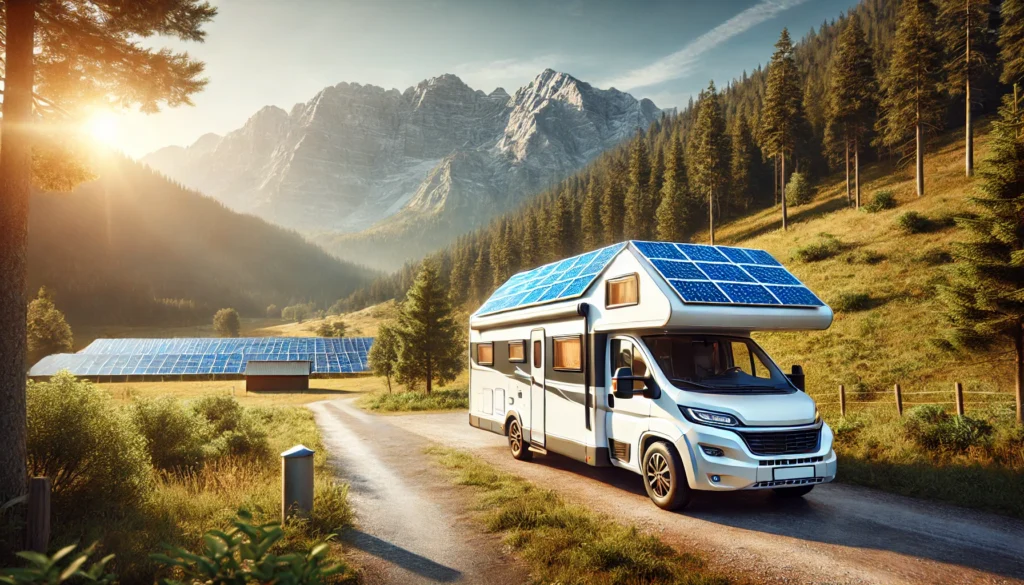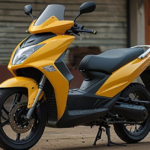When it comes to motorhome travel, freedom is the ultimate allure. The open road, the scenic landscapes, and the comfort of having your own home on wheels make motorhome adventures incredibly enticing. However, one major concern for motorhome owners is power. Traditional power sources like generators or hookups at campsites can limit the journey. Enter the game-changer: solar panels. Installing solar panels on a motorhome not only provides a clean, renewable energy source but also offers unparalleled freedom and flexibility. In this detailed guide, we’ll explore the benefits of motorhomes with solar panels, how they work, installation tips, and best practices to make your off-grid travel as efficient as possible.
Why Solar Panels for Motorhomes?
Before diving into the specifics, let’s discuss why solar panels are becoming a must-have for motorhome enthusiasts:
- Off-Grid Independence: One of the biggest advantages of solar panels is the ability to travel off-grid. You no longer need to rely solely on campsites or power hookups. Solar energy allows you to explore remote destinations, stay in the wilderness, and go wherever the road takes you without worrying about power supply.
- Cost-Efficiency: Although the initial investment in solar panels can be substantial, they offer long-term savings. With solar panels, you harness free energy from the sun, reducing your reliance on paid power sources like campsite electricity or fuel for generators.
- Environmentally Friendly: Solar panels provide a clean, renewable energy source, reducing the carbon footprint of your travels. Unlike generators, solar panels produce no emissions, noise, or fumes, making them an environmentally responsible choice for the eco-conscious traveler.
- Low Maintenance: Solar panels require minimal upkeep. Once installed, they can provide power reliably for years with little maintenance other than occasional cleaning and monitoring of the system’s performance.
- Quiet and Hassle-Free: Generators can be noisy and need regular fuel top-ups. Solar panels, on the other hand, operate silently, generating power as long as there’s sunlight. This is particularly beneficial if you’re camping in a serene natural setting where you want to maintain the peace and quiet.
How Do Solar Panels for Motorhomes Work?
Solar panels capture sunlight and convert it into electrical energy. Here’s a basic overview of how the system works:
- Solar Panels: The panels are made of photovoltaic (PV) cells that convert sunlight into direct current (DC) electricity. They are usually mounted on the roof of the motorhome for maximum exposure to sunlight.
- Charge Controller: The electricity generated by solar panels flows through a charge controller. This device regulates the power going into your motorhome’s battery system, preventing overcharging and ensuring efficient power use.
- Battery Bank: The stored energy is kept in a battery bank, which stores power for use when the sun isn’t shining (e.g., at night or during cloudy weather). Deep-cycle batteries, such as AGM or lithium-ion, are typically used in motorhome solar setups.
- Inverter: Most motorhome appliances and devices run on alternating current (AC) power. An inverter converts the DC power from the batteries into AC power, making it usable for your lights, appliances, and electronics.
- Power Usage: Once the solar energy is stored in the battery, it can be used to power various devices and appliances inside your motorhome, such as lights, refrigerators, fans, chargers, and even small kitchen appliances.
Choosing the Right Solar Panel Setup for Your Motorhome
Selecting the right solar panel system for your motorhome involves several considerations. Here’s a breakdown of key factors to guide your decision:
1. Type of Solar Panels
- Monocrystalline Panels: These are the most efficient solar panels available, making them ideal for motorhome use where roof space is limited. They are slightly more expensive but offer higher power output and a longer lifespan.
- Polycrystalline Panels: Slightly less efficient than monocrystalline panels but more affordable. They are a good option if you have ample roof space and are working within a budget.
- Flexible Panels: Lightweight and easy to install, flexible solar panels can be adhered to curved surfaces, making them perfect for certain types of motorhomes. However, they tend to be less durable and have a shorter lifespan than rigid panels.
2. Power Requirements
Understanding your power consumption is crucial when choosing a solar panel system. Make a list of the appliances and devices you plan to use and calculate their power usage. Motorhome solar systems are typically measured in watts. For example:
- Basic Setup (200W – 400W): Ideal for minimal power usage, such as charging phones, running lights, and powering small electronics.
- Medium Setup (400W – 800W): Suitable for more extended stays and moderate usage, such as running a refrigerator, charging multiple devices, and powering fans or small kitchen appliances.
- Advanced Setup (800W+): Designed for heavy power usage, supporting high-demand appliances like air conditioners, microwaves, or TV systems.
3. Battery Storage Capacity
The battery bank size is critical as it determines how much solar power you can store for later use. Deep-cycle batteries (e.g., AGM or lithium-ion) are recommended for solar setups due to their ability to handle repeated charge and discharge cycles. Lithium-ion batteries are lighter, have a longer lifespan, and charge more efficiently than traditional lead-acid batteries but come at a higher price.
4. Charge Controller
Choosing the right charge controller ensures that your batteries are charged safely and efficiently. There are two types to consider:
- Pulse Width Modulation (PWM): More affordable but less efficient, PWM controllers are suitable for smaller solar setups with lower power requirements.
- Maximum Power Point Tracking (MPPT): More expensive but highly efficient, MPPT controllers maximize the power output from your solar panels, making them ideal for larger, more advanced solar systems.
5. Inverter Size
An inverter’s job is to convert DC power (stored in the batteries) to AC power (used by most appliances). When choosing an inverter, ensure its capacity matches the total wattage of the devices you intend to power simultaneously.
Installing Solar Panels on Your Motorhome
Installing solar panels on a motorhome requires careful planning and the right tools. Here’s a step-by-step guide to get you started:
1. Determine the Mounting Location
Choose a location on the motorhome’s roof that receives maximum sunlight exposure. Ensure the panels won’t be shaded by vents, air conditioners, or roof racks, as shading can significantly reduce their efficiency.
2. Secure the Mounting Hardware
Most solar panel kits come with mounting brackets that allow you to securely attach the panels to the roof. Follow the manufacturer’s instructions for proper installation, ensuring the brackets are firmly in place to withstand wind and road vibrations.
3. Wire the Panels to the Charge Controller
Use the appropriate gauge wiring to connect the solar panels to the charge controller. Proper wiring ensures efficient power transfer and reduces the risk of electrical issues. It’s recommended to use waterproof connectors and secure the wires along the roof to prevent damage.
4. Install the Charge Controller and Battery Bank
Place the charge controller in an accessible location inside the motorhome, near the battery bank. Connect the charge controller to the batteries following the manufacturer’s instructions, ensuring that all connections are secure and free of corrosion.
5. Connect the Inverter
Install the inverter close to the battery bank and connect it using the appropriate cables. The inverter should have a sufficient power rating to handle the combined wattage of your appliances.
6. Test the System
Once everything is connected, test the system by turning on the solar panels and monitoring the charge controller’s display. Check that the batteries are charging correctly and that the inverter is supplying power to your motorhome’s outlets.
Maintaining Your Motorhome Solar System
Proper maintenance is essential to ensure the longevity and efficiency of your solar power system. Here are some key maintenance tips:
- Clean the Solar Panels Regularly: Dust, dirt, and debris can accumulate on the surface of solar panels, reducing their efficiency. Clean the panels with a soft brush and water to keep them free of obstructions.
- Inspect Wiring and Connections: Periodically check all wiring and connections for signs of wear, corrosion, or damage. Ensure that all connections remain tight and secure to prevent power loss or electrical issues.
- Monitor Battery Health: Keep an eye on the battery bank’s charge levels and health. Deep-cycle batteries should be regularly maintained to prolong their lifespan. Lithium-ion batteries generally require less maintenance but should still be checked periodically.
- Check the Charge Controller: Regularly inspect the charge controller to ensure it’s operating correctly. Most controllers have displays showing charging status, battery levels, and error messages. Address any issues promptly to avoid system damage.
Maximizing Solar Efficiency
To get the most out of your motorhome’s solar power system, consider these efficiency-boosting strategies:
- Optimize Panel Orientation: Park your motorhome in a way that maximizes sunlight exposure to the panels. Adjust the orientation as needed throughout the day to capture the most sunlight.
- Minimize Power Consumption: Use energy-efficient appliances and LED lights to reduce power consumption. Unplug devices when they’re not in use, and avoid running high-wattage appliances simultaneously to prevent excessive drain on the battery.
- Use Solar-Powered Accessories: Consider using solar-powered accessories, such as solar lanterns, fans, or chargers, to supplement your main solar system and conserve battery power.
- Consider Adding Portable Solar Panels: If your roof space is limited, portable solar panels can be a great supplement. These panels can be set up on the ground in sunny areas, providing extra charging capacity when you’re stationary.
The Future of Motorhome Solar Technology
As technology continues to advance, motorhome solar systems are becoming more efficient, compact, and affordable. Here are some trends to look out for:
- High-Efficiency Solar Panels: Solar panel technology is constantly evolving, with new materials and designs that offer higher efficiency rates. These advancements allow for more power generation in smaller spaces, which is ideal for motorhomes.
- Integrated Solar Roofing: Some motorhomes are now being designed with built-in solar roofs, eliminating the need for additional panel installation. These integrated systems provide a sleek, aerodynamic look and optimize power generation.
- Smart Solar Management Systems: Smart charge controllers and inverters are becoming more common, allowing for better monitoring and management of solar power systems. These devices provide real-time data on power generation, battery levels, and energy usage, helping users maximize their system’s performance.
- Energy Storage Innovations: Advances in battery technology, such as solid-state batteries and improved lithium-ion cells, promise longer lifespans, faster charging times, and greater energy storage capacity. These innovations will further enhance the appeal of solar-powered motorhomes.
Conclusion
Motorhomes with solar panels represent a perfect blend of freedom, sustainability, and convenience for modern travelers. With the ability to generate clean energy on the go, motorhome enthusiasts can explore off-grid destinations, reduce their carbon footprint, and enjoy cost-effective power without the noise and hassle of traditional generators.
Choosing the right solar system involves considering factors like panel type, power requirements, battery storage, and installation. By investing in a well-planned solar setup and following proper maintenance practices, motorhome owners can unlock the full potential of their adventures.
The road ahead is bright for motorhomes with solar power, as technological advancements continue to make these systems more efficient and accessible. Whether you’re a weekend camper or a full-time traveler, adding solar panels to your motorhome is a step towards a more independent and eco-friendly journey.







